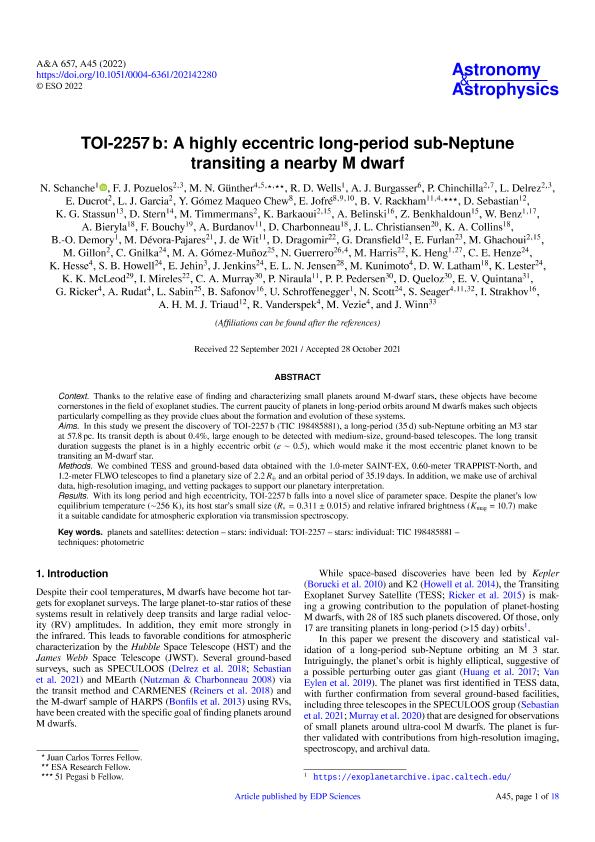Artículo
TOI-2257 b: A highly eccentric long-period sub-Neptune transiting a nearby M dwarf
Schanche, N.; Pozuelos, F. J.; Günther, M. N.; Wells, R. D.; Burgasser, A. J.; Chinchilla, P.; Delrez, L.; Ducrot, E.; Garcia, L. J.; Gómez Maqueo Chew, Y.; Jofre, Jorge Emiliano ; Rackham, B. V.; Sebastian, D.; Stassun, K. G.; Stern, D.; Timmermans, M.; Barkaoui, K.; Belinski, A.; Benkhaldoun, Z.; Benz, W.; Bieryla, A.; Bouchy, F.; Burdanov, A.; Charbonneau, D.; Christiansen, J. L.; Collins, K. A.; Demory, Brice Olivier; Dévora Pajares, M.; De Wit, J.; Dragomir, D.
; Rackham, B. V.; Sebastian, D.; Stassun, K. G.; Stern, D.; Timmermans, M.; Barkaoui, K.; Belinski, A.; Benkhaldoun, Z.; Benz, W.; Bieryla, A.; Bouchy, F.; Burdanov, A.; Charbonneau, D.; Christiansen, J. L.; Collins, K. A.; Demory, Brice Olivier; Dévora Pajares, M.; De Wit, J.; Dragomir, D.
 ; Rackham, B. V.; Sebastian, D.; Stassun, K. G.; Stern, D.; Timmermans, M.; Barkaoui, K.; Belinski, A.; Benkhaldoun, Z.; Benz, W.; Bieryla, A.; Bouchy, F.; Burdanov, A.; Charbonneau, D.; Christiansen, J. L.; Collins, K. A.; Demory, Brice Olivier; Dévora Pajares, M.; De Wit, J.; Dragomir, D.
; Rackham, B. V.; Sebastian, D.; Stassun, K. G.; Stern, D.; Timmermans, M.; Barkaoui, K.; Belinski, A.; Benkhaldoun, Z.; Benz, W.; Bieryla, A.; Bouchy, F.; Burdanov, A.; Charbonneau, D.; Christiansen, J. L.; Collins, K. A.; Demory, Brice Olivier; Dévora Pajares, M.; De Wit, J.; Dragomir, D.
Fecha de publicación:
01/2022
Editorial:
EDP Sciences
Revista:
Astronomy and Astrophysics
ISSN:
0004-6361
e-ISSN:
1432-0746
Idioma:
Inglés
Tipo de recurso:
Artículo publicado
Clasificación temática:
Resumen
Context. Thanks to the relative ease of finding and characterizing small planets around M-dwarf stars, these objects have become cornerstones in the field of exoplanet studies. The current paucity of planets in long-period orbits around M dwarfs makes such objects particularly compelling as they provide clues about the formation and evolution of these systems. Aims. In this study we present the discovery of TOI-2257 b (TIC 198485881), a long-period (35 d) sub-Neptune orbiting an M3 star at 57.8 pc. Its transit depth is about 0.4%, large enough to be detected with medium-size, ground-based telescopes. The long transit duration suggests the planet is in a highly eccentric orbit (e ∼ 0.5), which would make it the most eccentric planet known to be transiting an M-dwarf star. Methods. We combined TESS and ground-based data obtained with the 1.0-meter SAINT-EX, 0.60-meter TRAPPIST-North, and 1.2-meter FLWO telescopes to find a planetary size of 2.2 R⊕ and an orbital period of 35.19 days. In addition, we make use of archival data, high-resolution imaging, and vetting packages to support our planetary interpretation. Results. With its long period and high eccentricity, TOI-2257 b falls into a novel slice of parameter space. Despite the planet’s low equilibrium temperature (∼256 K), its host star’s small size (R∗ = 0.311 ± 0.015) and relative infrared brightness (Kmag = 10.7) make it a suitable candidate for atmospheric exploration via transmission spectroscopy.
Archivos asociados
Licencia
Identificadores
Colecciones
Articulos(CCT - CORDOBA)
Articulos de CTRO.CIENTIFICO TECNOL.CONICET - CORDOBA
Articulos de CTRO.CIENTIFICO TECNOL.CONICET - CORDOBA
Citación
Schanche, N.; Pozuelos, F. J.; Günther, M. N.; Wells, R. D.; Burgasser, A. J.; et al.; TOI-2257 b: A highly eccentric long-period sub-Neptune transiting a nearby M dwarf; EDP Sciences; Astronomy and Astrophysics; 657; 1-2022; 1-18
Compartir
Altmétricas



